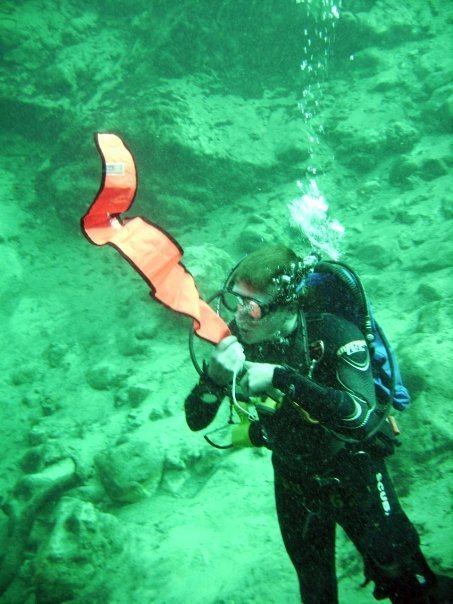Acronym SMB, DSMB | ||
 | ||
Other names Delayed surface marker buoyDecompression buoyDeco buoyBlob Uses Marking the position of a group of diversMarking the position of a diver making an ascentSignal to the surface party that assistance may be needed | ||
A surface marker buoy, SMB or simply a blob is a buoy used by scuba divers, with a line, to indicate the diver's position to their surface safety boat while the diver is underwater. Two kinds are used; one (SMB) is towed for the whole dive, and indicates the position of the dive group, and the other (DSMB) is deployed towards the end of the dive as a signal to the surface that the divers have started to ascend. Both types can also function as a depth reference for controlling speed of ascent and accurately maintaining depth at decompression stops.
Contents
A "safety sausage" is a low volume tubular buoy inflated at or near the surface to increase visibility of the diver.
Standard buoy
SMBs are floated on the surface during a dive to mark the diver's position during drift dives, night dives, mist or disturbed sea conditions such as Beaufort force 2 or greater. The buoy lets the dive boat follow the divers and highlights their position to other boat traffic.
Buoys for this use are usually either inflated and sealed by a valve or cap, or made from buoyant material, so they do not deflate or flood during the dive, rendering them ineffective. High-visibility colours such as red, orange and yellow are popular. Sometimes the float includes a diving flag.
To avoid losing the reel, a lanyard may be used to attach the diving reel to the diver. This lanyard can clip to the buoyancy compensator or go around the wrist. Alternatively, the lanyard can be long enough to float above the diver and stay out of the way. If the lanyard clips to the buoyancy compensator, the user should take care to release if there is surface boating activity, as boats may drag divers up by their SMB reels.
The DIR diving philosophy considers unsafe any attachment of the diver to equipment or objects which end above the water surface, due to high risk associated with dragging the diver upwards in spite of their decompression obligation or maximum ascent speed limit.
Other uses
Competitors in the underwater sport underwater orienteering are required to tow a SMB with a buoyancy of at least 8kg during competition swims. This is both for safety, and to allow the judges to monitor the route taken by the diver and to score the points for time and accuracy. Such SMB's are designed for low drag, which is a useful feature in any SMB that will be towed by the diver.
A GPS tracker can be mounted on the SMB to record a dive track. This can be downloaded and used to establish positions of underwater landmarks with reasonable accuracy depending on surface conditions and current.
Decompression buoy
A delayed surface marker buoy (DSMB), decompression buoy or deco buoy is similar to a surface marker buoy but is deployed whilst the diver is submerged and generally only towards the end of the dive. The buoy marks the diver's position underwater so the boat safety cover can locate the diver even though the diver may have drifted some distance from the dive site while doing decompression stops. A reel and line connect the buoy on the surface to the diver beneath the surface. Alternative means of marking one's position while doing decompression stops are diving shots and decompression trapezes.
A closed SMB, inflated through a valve, is likely to be more reliable, by remaining inflated, than an open ended buoy which seals by holding the opening under water. A decompression buoy is not intended to be used to lift heavy weights: for this purpose divers use a lifting bag.
Design
There are at least four methods of keeping the air in the inflated deco buoy. The buoy can be:
Divers of some training organisations carry two differently coloured deco buoys underwater so that they can signal to their surface support for help and still remain underwater decompressing. For example, in some circles in Europe, a red buoy indicates normal decompression and a yellow buoy indicates a problem, such as shortage of gas, that the surface support should investigate and resolve. Although in other circles, two buoys (any colour) up one line means the same, currently the protocol is not universally accepted even within Europe.
Some types of buoy provide an attachment for a strobe light, cyalume stick or writing slate, which can convey signals to the surface support.
Deployment problems
Several common problems are encountered when deploying deco buoys.
Safety sausage
A safety sausage is an inflatable buoy used when the diver is at the surface to indicate the diver's position to the dive boat, reducing the risk of losing contact when air, light or sea conditions decrease the visibility of the divers from the boat. The sausage is a plastic tube that is normally inflated by putting one end under water and purging the second stage underneath to inflate it. Inflated tubes are normally about 6 feet (2 m) tall. Uninflated sausages roll up and fit in a buoyancy compensator pocket. Commercial boat dive operations, especially at offshore reefs or areas known for strong currents or mercurial weather, may require divers to carry safety sausages. A safety sausage is not a substitute for a surface marker buoy or diver down flag.
